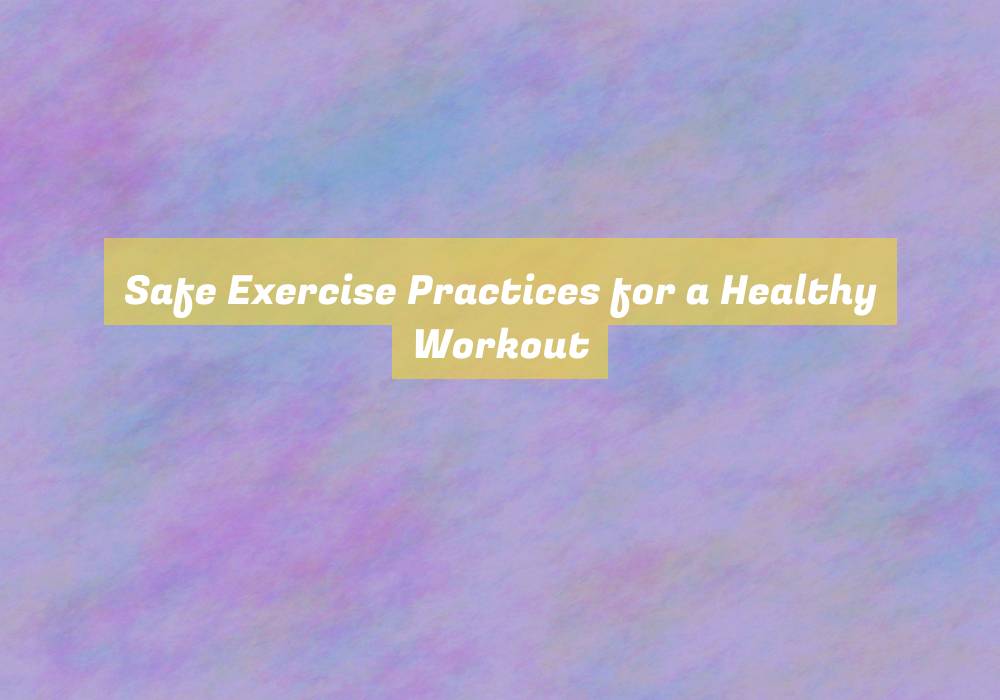Safe Exercise Practices for a Healthy Workout
You know that feeling when youG??re driving and the low fuel light suddenly comes on? ItG??s a signal that itG??s time to refuel to keep the engine running smoothly. Just like your car, your body also needs the right fuel and maintenance to perform at its best, especially when it comes to exercise.
But what if you could avoid the metaphorical G??low fuelG?? warning altogether? There are key practices that can help you exercise safely, preventing potential setbacks and ensuring a healthy workout.
It all starts with understanding the benefits of safe exercise and implementing essential safety precautions.
Benefits of Safe Exercise
Engaging in safe exercise practices offers numerous health benefits. Regular physical activity improves cardiovascular function and increases muscular strength. It strengthens your heart and makes it more efficient at pumping blood, reducing the risk of heart disease and high blood pressure. Safe exercise also increases muscular strength and endurance, making daily tasks easier and reducing the risk of injury.
Incorporating safe exercise practices into your routine improves flexibility and joint mobility, enhancing your overall quality of life. It also has positive effects on mental health, reducing symptoms of anxiety and depression while boosting mood and self-esteem. The benefits of safe exercise are extensive and impactful, contributing to physical, mental, and emotional well-being.
Therefore, it is important to prioritize engaging in safe exercise practices regularly to reap these valuable rewards for your health and vitality.
Essential Safety Precautions
To ensure your safety during exercise, always warm up and cool down properly to prevent injury and promote optimal performance. A thorough warm-up increases blood flow to your muscles, making them more flexible and reducing the risk of strains or tears. It also prepares your cardiovascular system for the upcoming workout. Spend at least 5-10 minutes doing light aerobic exercises like jogging, jumping jacks, or cycling before diving into more intense activities.
After your workout, take the time to cool down by gradually decreasing the intensity of your exercise. This allows your heart rate to return to its resting state and prevents blood from pooling in your muscles, reducing the risk of dizziness or fainting.
Furthermore, always use proper form and technique when performing exercises to avoid unnecessary stress on your muscles and joints. ItG??s also crucial to stay hydrated throughout your workout to regulate your body temperature and maintain peak performance. Additionally, listen to your body and donG??t push yourself too hard, especially if youG??re feeling fatigued or in pain.
Lastly, if you have any pre-existing medical conditions or concerns, consult with a healthcare professional before starting a new exercise regimen.
Proper Warm-Up Techniques
After ensuring your safety through essential warm-up and cool-down practices, focus on proper warm-up techniques to maximize the benefits of your exercise routine. A proper warm-up is crucial for preparing your body for the physical demands of your workout. Start with 5-10 minutes of light cardio, such as brisk walking, jogging, or cycling, to gradually increase your heart rate and warm up your muscles. This helps improve blood flow to the muscles and prepares them for more intense activity.
Following the cardio warm-up, incorporate dynamic stretching to further prepare your muscles for the specific movements involved in your workout. Dynamic stretches involve controlled movements that gently take your muscles through their full range of motion. This can include exercises like leg swings, arm circles, and hip rotations. Avoid static stretching at this stage, as it may not be as effective in preventing injury during the workout.
Additionally, consider incorporating sport-specific movements or drills into your warm-up routine. This can help prime your neuromuscular system and improve coordination and agility for the specific activities youG??ll be engaging in.
Injury Prevention Strategies
Implementing proper warm-up techniques is essential for preventing injuries during your workout routine. In addition to a thorough warm-up, there are several injury prevention strategies you should incorporate into your exercise regimen.
First and foremost, ensure that youG??re using the correct form and technique for each exercise. This wonG??t only maximize the effectiveness of your workout but also significantly reduce the risk of injury.
ItG??s also crucial to listen to your body and not push yourself beyond your limits. Overtraining and ignoring pain or discomfort can lead to serious injuries.
Another important aspect of injury prevention is incorporating rest days into your workout schedule. Giving your body time to recover is essential for preventing overuse injuries.
Furthermore, donG??t forget to include a cool-down session at the end of your workout. This will help lower your heart rate and prevent blood from pooling in your muscles, reducing the risk of dizziness or fainting.
Conclusion
So, remember to always prioritize safety during your workouts.
By following these safe exercise practices, you can ensure a healthy and injury-free experience.
Take the time to warm up properly, listen to your body, and implement injury prevention strategies.
Your health and well-being are worth the extra effort, so make safe exercise a priority in your fitness routine.
Happy and safe exercising!






I totally get that feeling you described! It’s like you’re just cruising along, and suddenly, there’s that reminder that you need to take care of business. I’ve found that when I make a habit of listening to my body—like knowing when I need to refuel with better nutrition or rest—I really notice a difference in my workout performance.
I hear you on that! It’s wild how our bodies send us signals we often ignore, right? Listening to what they need can be a game changer. I’ve started trying to pay more attention to my energy levels and adjust my meals or rest accordingly. It’s kind of like tuning into my own personal coach. Do you have any favorite meals or go-to strategies for recharging? I’m always looking for new ideas to keep things fresh.